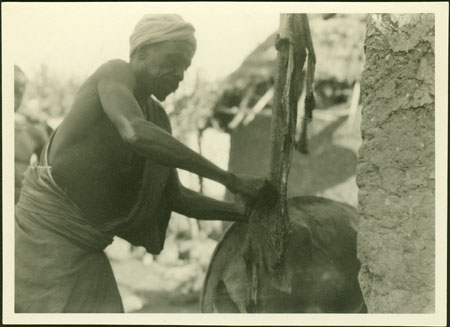Ingessana hide tanning

103 x 76 mm | Print gelatin silver
There are records relating to alternative images that we do not have scans for in the database:
1998.344.36.1 - Negative film nitrate , (103 x 76 mm)
1998.344.36.1 - Negative film nitrate , (103 x 76 mm)
Date of Print:
Unknown
Previous PRM Number:
EP.D.36
Previous Other Number:
H 11
Accession Number:
1998.344.36.2
Description:
A man scraping the meat off a skin suspended by a rope from a pole next to a hut, with a tethered donkey beyond.
The skin is first washed in a liquid prepared from the mudus tree, which grows locally.
Much of the leather produced was sold to merchants and was traded in Omdurman where it was rated highly.
Photographer:
Edward Evan Evans-Pritchard
Date of Photo:
1926 November - December
Region:
Blue Nile Tabi Hills ?Soda
Group:
Ingessana (Gaam)
PRM Source:
Edward Evan Evans-Pritchard
Acquired:
Donated 1966
Other Owners:
E. E. Evans-Pritchard Collection
Class:
Leatherwork , Shelter
Keyword:
Animal Donkey , Building
Activity:
Manufacturing
Documentation:
Original catalogue lists in Manuscript Collections. Additional material in related documents files. [CM 27/9/2005]
Primary Documentation:
PRM Accession Records - Accession Book Entry [p.
98] 1966.27 [1 - 24] G[ift] PROFESSOR E.
E.
EVANS-PRITCHARD; INST.
OF SOCIAL ANTHROPOLOGY, 51 BANBURY RD.
OXFORD - 1966.27.19 - S.
SUDAN, DARFUNG.
VARIOUS TRIBES.
Box of negatives in envelopes, [1 - 242] & 1966.27.20 - Box of prints of these negatives [refers to object 1966.27.19] [1 - 242], in envelopes.
Manual Catalogues [typewritten, entitled "Ingassana"] - 36. Scraping skin in tanning. H.11
Note on print reverse ms pencil - "duplicate H 11"
Manual Catalogues [typewritten, entitled "Ingassana"] - 36. Scraping skin in tanning. H.11
Note on print reverse ms pencil - "duplicate H 11"
Other Information:
In A Preliminary Account of the Ingassana Tribe in Fung Province, Sudan Notes and Records X, 1927, page 78, E.
E.
Evans-Pritchard notes that 'The Ingassana use the bark of the mudus tree, as it is called in Arabic, for tanning.
This tree grows in plenty in the Tabi hills.
Much of the leather is sold to merchants and probably finds its way to Omdurman, where mudus leather is esteemed higher than any other.
It is also used locally for water-skins.
Tanning is men's work and is done by skilled persons, though it is open to anyone to acquire the skill.' [Chris Morton 2/2/2004]
Recorder:
Christopher Morton 2/2/2004 [Southern Sudan Project]

